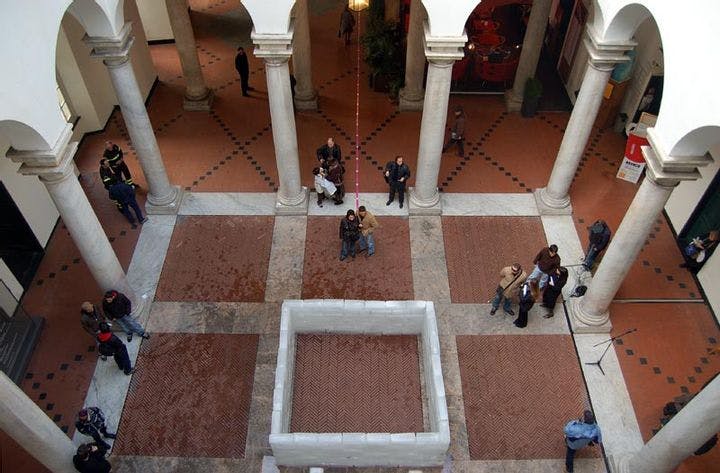Summer 2008
Still Happening
– Andrew Starner
Andrew Starner on Allan Kaprow, "the most known unknown artist of the 20th century.
It’s the ’60s all over again! Anyone who has frequented modern art museums in the last decade has seen numerous exhibitions of experimental art from a period that intended to make museums obsolete. “Kunst als Leben—Art as Life,” a traveling exhibit that opened two years ago in Munich and closes this fall in Genoa, is one of the most successful shows to engage with the ambivalence of the avant-garde toward museums. The exhibit is devoted entirely to the work of Allan Kaprow, who is credited with inventing the term “happening” to describe performances that blend painting, sculpture, and theater. Kaprow has been called the most known unknown artist of the 20th century (he referred to himself as an “Un-Artist/Non-Artist”), but a spate of attention is the bittersweet result of his death in 2006.
Kaprow characterized his work as action painting that left the canvas behind. His happenings—in which multiple events take place together in space and time, and can never be repeated in exactly the same way—are poised between the abstract expressionism of the ’50s and the pop art of the ’60s. Performance art wasn't invented in the ’60s, but it started to be recognized in its own right, mainly because of the word Kaprow coined. For many in the art establishment, “happenings” seemed fatuous, a notion that performance artists did nothing to dispel. “Happenings are events that, put simply, happen,” Kaprow wrote. “Their form is open-ended and fluid; nothing obvious is sought and therefore nothing is won, except the certainty of a number of occurrences to which we are more than normally attentive.”
For his 1966 piece Self-Service, for example, instructions were posted in four U.S. cities with separate but linked proposals for the participants:
NEW YORK
(Available Activities)
Everyone watches for either:
a signal from someone
a light to go on in a win- dow.
a plane to pass directly over- head.
an insect to land nearby.
three motor- cycles to barrel past. Immediately afterwards, they write a careful description of the occurrence, and mail copies to each other.
Although it is difficult to periodize Kaprow’s work, by the early ’70s his emphasis had shifted from large-scale happenings to more intimate works—which he termed “activities” and then “environments”—that dispensed with large casts, and could be experienced by a couple, or solo. But his works never lost their preoccupation with time, with something that happens.
Art as Life, an exquisite catalog of the exhibition, features almost 300 lavish pages of full-color photographs, manuscript reproductions, exhibition posters, art reviews, and instructions for the performance of Kaprow’s pieces; many of the materials are drawn from his papers held at the Getty Research Institute. It is an impressive trove of art resistant to archiving, art that seeks to abolish art objects by leaving no artwork behind after a performance and by incorporating quotidian objects, a strategy that coincided with the use of found objects for which Robert Rauschenberg became known. But a Rauschenberg can hang on a wall and be sold at auction. How can a price be put on a piece composed of a ball of street trash or blocks of ice—the products, respectively, of Kaprow’s pieces Round Trip (1968) and Fluids (1967)? How can a work that requires the concerted effort of numerous participants be put on permanent display?
Kaprow himself struggled with the legacy of his works, which were tied all but inextricably to his active participation. His collaboration in the Munich exhibit as his health was failing is movingly described by Stephanie Rosenthal, curator of contemporary art at Haus der Kunst, Munich, in her contribution to the catalog. For the first time, Kaprow allowed other artists to follow his procedures, to make “new versions” of his works. These reinventions (they are not reenactments—they often take on independent forms) come close to recreating the experience of being in a Kaprow piece, and being “in” is important: Active participation is demanded from spectators.
The real gem of Art as Life is the essay “Writing the Happening,” in which University of Michigan art history professor Alex Potts opens a window to Kaprow’s engaging, frustrating, and at times tedious texts. Kaprow’s instructions glitter with the polish and concentration of concrete poetry. The experience of experience, the gap in experience, is the revelation of the happening, and, inexplicably, to read these defiant activity booklets, these scores of hesitations and diversions, is to bring his art back to life.
* * *
Andrew Starner is a graduate student in theater and performance studies at Brown University.
Reviewed: "Allan Kaprow - Art As Life" Edited by Eva Meyer-Hermann, Andrew Perchuk, and Stephanie Rosenthal, Getty, 2008.
Photo courtesy of Flickr/giulio nepo
Up next in this issue
